Don't wanna be here? Send us removal request.
Video
tumblr
RELEASE
EZLO The Million Dollar Vintage Polo Collection These are the Warhol prints of our generation
Welcome to the vintage Polo collection. A collection of the most rare and sought after items by America’s greatest artist - Ralph Lauren. Featuring 100 of the most important fashion art pieces ever created. A collection so iconic, it created a culture.
This collection and these items were the beginning of the original fashion culture. Before the Supremee’s were were getting chased by the Ape, before the Sneakerheads were camping out on the street and re-selling on the internet, before every long line at at Nike, A Bathing Ape, Kith, Palace, or any streetwear brand, there was Lo. Polo is a brand that organically developed a fanbase without even trying. For every store with a line to get into, for every online forum focusing on a fashion brand, for every fashion label with a sub-culture, for every designer making “Streetwear”, thank Ralph Lauren and the Lo Life Polo collectors who created this platform.
These are the 100 rarest vintage Polo Ralph Lauren items from the 1987-1994 Collection. This showcase is a celebration of the 50th anniversary of Polo Ralph Lauren, and a 25th anniversary of the highly coveted 1992 collection. This archive has taken over 20 years to build. The Polo collectors within this culture refer to themselves as Lo Lifes or Lo Heads. Today we meet Ezra Wine, an OG Polo collector and we review his collection.
Ezra collects vintage Polo Ralph Lauren items from the 1987-1994 period. He started collecting when he was 15 in 1995 and has been obsessed from day one. His collection consists of the 100 most rare, most exclusive, most limited, most elite Polo power pieces. The collection is kept at his showroom in SoHo, where he was born and raised. Just like Ralph, his father is a painter, and he was immediately drawn to the artistic styles of the pieces in this collection. Each one of the pieces has a story, of why they’re important as a design and why they’re important to the community of fellow collectors. After 20 years in the game, it’s time to retire. Today, he’s selling his collection. No trades, no deals, no size swaps. Items will not be sold separately. This 100 piece collection is for sale, for a cool million.
The story of the vintage Polo culture started in the late 1980’s when lower income youth from Brooklyn became obsessed with the Polo style and status and literally stole the image. Polo was the aspirational, All-American, high end designer brand that was never going to market themselves to urban communities, and that’s why they wanted it. Their desire and risk gave birth to the culture we know today. These are people that are obsessed with all things Polo Ralph Lauren. The name Lo, comes from Polo, and for the last twenty five years this subculture has been changing the face of Hip Hop fashion.
Today they are buyers, collectors, sellers and addicts of vintage Ralph Lauren clothing. The movement has spread around the world and reached a diverse collective of collectors, but it all began in Brooklyn New York. The story of the Lo Culture starts in the late 1980’s in the Crown Heights section of Brooklyn.
The Lo Lifes were a gang, formed by African-American and Hispanic teens from low income housing projects. The gangs robbed residents and sold drugs, but they were most interested in stealing from clothing stores like Macy’s, Bloomingdales and B. Altman’s. The gangs started with the names ‘Ralphie’s Kids’ from St. Johns Projects, and ‘Polo U.S.A.’ (United Shoplifter’s Association) from Marcus Garvey Village projects, then they joined forces to form the “Lo Lifes”. They became obsessed with designer labels. Coming from poor communities, they aspired to have the status of a Gucci jacket or a Fendi bag. But the brand they most looked up to was Polo Ralph Lauren. To these kids nothing was more of a status symbol than the iconic Polo horse from Ralph’s brand. Lauren had spent 20 years establishing his company as the ultimate in preppy attire for the country club and private school community. These minority adolescents saw this and wanted to represent the elite lifestyle that Polo stood for. They did not desire the educated lives and Wall Street careers that the horse represented, but they wanted the image. They came from low income families lacking the resources to buy designer labels. This was their chance to look like the wealthy prep school kids they rode the train with, while staying true to their communities as gang members that stole anything they wanted.
In 1987 the group of teens would organize shoplifting adventures they called the “Million Man Rush.” These ‘kleptomaniacs’ would walk into Macy’s with 50 kids, grabbing all the Polo leather jackets and sweaters they could carry and run out. Security could not stop them and workers feared them. They pulled stunts like this at Bloomingdales, and many other stores in Brooklyn and Manhattan. The “Lo” pieces were then taken to Brooklyn where they were sold and traded amongst their community. Examples of the culture are heard in Hip Hop as Rapper Jay Z mentions this in his song Where I’m From, stating “I'm from where the beef is inevitable, summertime's unforgettable, Boosters in abundance, buy a half-price sweater new.”
The gang would also rob individuals who had clothing labels they desired. Rapper Thirstin Howl the 3rd was a founding member of the gang, proclaiming to have stolen thousands of “Lo” pieces from stores and reselling the designer goods to Brooklyn friends, or giving them away to their girlfriends, or as they called them “Lo wives.” Examples of the risk of the culture could also be heard in Jay Z’s BK Anthem, “It wasn't safe on the A train, D, G or the F, Decepticons, Lo-Lifes snatch the polo off your chest”
From a style perspective this subculture was engaging in the classic battle between the lower classes desire to have the status of the wealthier class. Prior to ’87 Polo was mostly known for their small embroidered horse icon on the left breast of tennis shirts. This image stood for aspiration, however the 1987 collection marked the 20th anniversary of Ralph Lauren (1967-1987). To celebrate, Polo released a large collection of anniversary novelty designs that were loud with lettering and imagery showcasing the lifestyle that had only been seen in their advertising and in the concept of the horse logo. Now Polo was being seen for making bright and colorful boating shirts with Yachting imagery on the back, cross flags sweatshirts showing the anniversary year and ski jackets with actual skier cartoons on the items. It is unclear how the general fashion community reacted to these new styles from Polo, but it was obvious that the “Lo Lifes” had taken a strong liking to the artistic designs.
As the 1990’s began the “Lo” subculture had expended all over New York. The term “Lo heads” developed to mean non-original gang members who were still involved in the subculture. Members became diverse as New York City with the influx of Asians and Caucasians getting involved in this black market system. It became common knowledge for New York City high school kids to either steal from Polo stores themselves, or attempt to purchase/trade items from other “Lo heads.” High schools in Brooklyn, Manhattan and Queens had become hotbeds for the Lo subculture. Common language developed among the members in terms of shirt names, and codes like “eats” meaning holes, “beat” for damaged shirts, “Lizzy tags” for store security sensors. As the pieces changed hands and the popularity increased, the values went up. What had begun as high priced stolen merchandise, being sold for half price, had turned into highly collectible timeless apparel that was now selling for above the original retail price. “Lo heads” began preferring to trade items as opposed to buying and selling, because amongst the community cash was not desired. In order to get the pieces one wanted, one had to trade an item of equal rarity and value.
In Hip Hop media artists like Grand Puba from Brand Nubian were wearing and rapping about “Lo” in his song, That’s how we move it, stating “It's time to switch it up so I'll breeze back to the rest, put on some Polo gear and a baggy pair of Guess.”
Artists like Wu Tang Clan were dropping lines in songs like C.R.E.A.M. (Cash Rules Everything Around Me) “My life got no better, same damn 'Lo sweater, Times is rough and tough like leather.”
Other hip hop groups such as “Another Bad Creation” went one step further in music videos and popularized the style of wearing store security sensors on the clothing. This was a bragging right displaying that one had style and status, but proving that one stole it. This concept is similar to hunters in medieval times that would wear the skin of a bird they had shot down prior, as a way to visually brag about their hunting skill.
As the subculture evolved members became heavily involved in trading with one another. Much like their youth trading baseball cards years earlier, these high schoolers developed connections with members via phone calls and street meetings. Common meeting places were downtown Manhattan shopping destinations like EMS on Broadway, The Atrium on Bleecker Street and Tent and Trails on Park Place. Specific pieces began to develop common names and understood values based on original retail price, design, rarity and desirability. Members were still robbing other members and from stores. One notable piece was a ski jacket that developed the “street name” the “suicide ski” or “sui” referring to the fact that wearing this specific jacket was the equivalent of suicide, as so many youths were getting robbed and slashed with knives from people trying to rob them for that specific jacket.
Once again the 1992 collection marked the first Olympic sponsorship for Mr. Lauren and the 25th anniversary of Polo and once again celebrated with a flashy group of styles that was highly sought after and stolen from stores. From a marketing side Polo developed a new sub brand called Polo Sport, which became the label for “Lo heads.” They also hired their first African American model, named Tyson Beckford, which was a shock to the fashion world as Polo had previously only used Caucasian models to represent their brand. Tyson was a muscular tattooed teen who had been discovered by a Polo marketing representative. In hip hop media, artist Raekwon states in the Wu Tang Clan song, ‘Still Strugglin’ “A young youth, yo rockin' the gold tooth, 'Lo goose, only way I began to G off was drug loot.” He also became famous for wearing the “Polo Snow Beach” jacket in the ‘Can it be so simple’ music video.
In the 2000’s “Lo heads” and the original “Lo Lifes” were heavily involved in the subculture as the growth of the Internet spread their story. Vintage clothing sites like ebay.com became the go to source for buying and selling “Lo”, and prices had skyrocketed due to the notoriety of the items. Members of the sub-culture were popping up in major fashion cities like Chicago, Atlanta, Las Vegas, New Jersey, California, Tokyo, Paris, Munich, etc. What began as an underground Brooklyn culture of stealing from department stores and wearing those items as a badge of honor, had become an international culture.
Hip Hop clothing stores such as Flight Club New York and Fruition Las Vegas, began to sell vintage Polo on their racks alongside brand new hip hop apparel from Nike, Jordan and Adidas. In hip hop media, artists such as Kanye West and Fabolous were wearing “Lo” in all of their music videos further promoting the clothing. As the items got older members became more like collectors. Being neurotic about cleanliness of the items, carefully hand washing their collections and proper storage of their antiques. “Lo heads” would spend entire evenings in their homes working on complex trades with other members in order to obtain the most sought after articles of the collection. Members had been known to bring garment bags with 50 items to do a trade in another member’s home.
Today the “Lo head” community is going strong, countless articles in Hip Hop magazines, worldwide membership and the Internet helping to promote this subculture and the collector’s items that members are still obsessing over. The current success of the culture is a mix of nostalgia for vintage clothing and the appreciation of Polo as an elite status brand name.
What makes this subculture so ironic is the true story of Ralph Lauren, who was born in the Bronx NY in 1939 to poor Russian-Jewish parents. His father Frank Lifshitz used the last name “Lauren”, due to anti-Semitism, to get house painting jobs in the Bronx. When Ralph started his clothing line in 1967 he used the name “Lauren” and the brand name “Polo” to signify the all American old money lifestyle that the company would come to represent. He was an immigrant who wanted the image of elite wealthy status. The irony is 20 years into the brand, “The Lo Lifes” sought the same image and aspired to obtain the status that was part of the Polo name.
Mr. Wine is selling his collection because it's a museum style collection that belongs in a museum. These are the Warhol prints and Basquiat paintings of his generation. It took him over 20 years to build and he wants to see this collection at the Whitney, The Smithsonian or at the Metropolitan Museum of Art.
As a high school student Ezra understood the really important special pieces from Polo were not going to be available at Macy's and the Atrium, they were only going to be available on this black market, sold by individuals and fellow collectors that had them. He started connecting with collectors spending all his money meeting other members of the culture on lower Broadway, at Wendy’s, in front of EMS, Brooklyn train stations, doing trades, or buying pieces directly from the community.
The Polo Black market had a value system like no other, where vintage pieces, had retail prices that might have been lower when these items came out years before, but as they get older and more popular, and more collectors are involved in the culture, the prices keep going up. Some of these prices are way beyond their original retail cost. Mr. Wine is an artist and an art and fashion collector. His mom is from the south side of Chicago, and his father from North side. His parents came to New York in the ‘60s, his mom worked in the garment center for 40 years, and his father is an artist and a math teacher.
This is a community of people that really prefer to trade, because anybody can get cash. Cash has no value, other pieces have value. This is a community in a culture where if you don't have the pieces, nobody wants to do deals with you. People never want to sell a white summer hat, they want to trade a white summer hat, because they want the red summer hat.
Back in 2003 Mr. Wine was selling items to celebrities, rappers and people that work in hip-hop. Doing deals with Kanye West, Fabolous and Just Blaze. He wanted to put these pieces back on the fashion map. He wanted Kanye and Fabolous to wear these items that Grand Puba and Wu-Tang had worn previously. He was doing it to keep the culture alive and on the front page of the hip-hop media. When Fabolous wanted the gray cashmere bear sweater for the ‘Baby’ music video, it wasn't for sale, but it was rented to Fab for a one-day shoot, he wore the sweater in the video and got a lot of online hype with Polo collectors talking about the bear sweater online, and Ezra still owns that actual bear sweater that Fab wore in the video. He’s never worn it since, and it is part of this immaculate collection.
When Kanye wanted pieces for his College Dropout tour, they came to Ezra. And when Just Blaze wanted pieces for some photo shoots, he came to Ezra. And then years later when Chris Brown wanted to wear the Snow Beach Raekwon jacket on the NBC Today Show concert, they came to Ezra.
Eventually Mr. Wine became so obsessed with the sport graphics and the unique funky imagery in these Polo items that he decided to create his own clothing line based on that vintage Polo look and feel. In 2004 he started making graphic tees and button ups with sports characters, bright colors and often times using actual vintage Ralph Lauren fabrics to make custom pieces. His clothing designs are an homage to vintage Polo. He thinks of vintage Polo as an inspiration for the items that he’s made, thinking not only about the high-quality unique designs, but also about this incredible community and culture that formed around those pieces.
This collection is for sale for a million dollars, and it’s worth a million dollars. The values go up every day. It’s priceless. If it doesn’t sell, he’s happy to keep it. This collection is 20 years of labor. For some of these pieces, he spent 10 years just asking collectors about them, only to get a lead on who owned it, only to hear that they’re keeping it.
This movement is so strong that in the fall of 2017 Polo will launch a limited edition capsule collection of retro 1992 Stadium P-Wing pieces. These remakes have led to additional hype within the Polo collector community, as this is the first time that Polo is releasing retro versions of these collectors items, following the success of the retro Nike Air Jordan collection that began in 1994. Ralph is actually listening to the collectors that he seemed to ignore for the last 25 years. These retro items will allow older collectors to re-buy items from their past, and open up the culture to a new younger generation of buyers. These remakes will be a nice reminder of the ‘92 collection. However the original antiques will always be the OGs.
This is one person’s chance to own the collection that created a culture. To own the most important pieces of hip-hop fashion history.
11 notes
·
View notes
Text
Key Pieces
A dozen of the power pieces from the collection
Dropbox: https://www.dropbox.com/sh/z6g1iu2qc0zps38/AABddOIFGQeV50xp4apjzdpla?dl=0
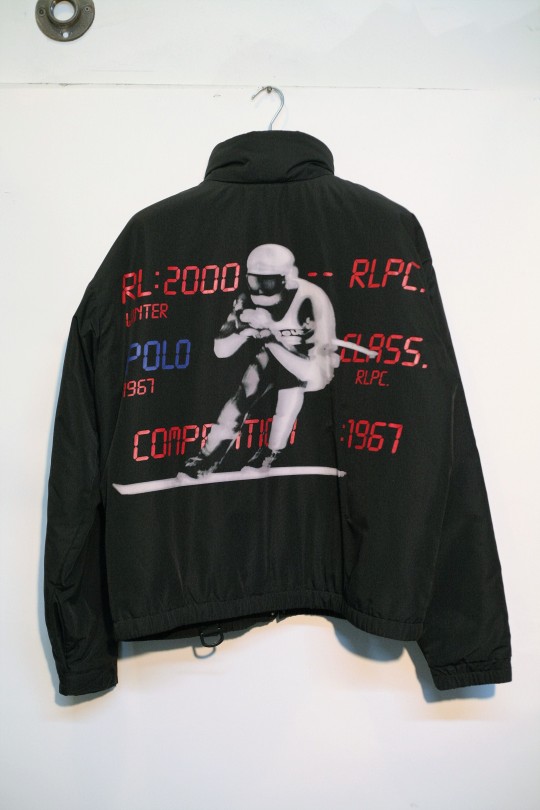
The Ghost Ski Jacket is part of the RL 2000 series released in 1994. The nickname created by collectors referring to the cartoon skier design resembling a white ghost. The name became fitting years later as collectors saw the RL 2000 series as the end of this unique and wild design era, almost as if the style itself was exiting, or as rappers of that early 90’s era would state their departure, by saying “I’m Ghost.” This size Large nylon down filled black puffer jacket features a blank front and the artwork on the back. The RL 2000 series was known for technical features, futuristic and reflective designs. There is also a matching long sleeve Tee Shirt as part of this set, that is featured in this collection. The RL 2000 series as a whole was a wide ranging group of mens and womens garments and accessories mostly in the Black, Silver and Red colorway. Most pieces featured a simple RL 2000 rubber patch, this jacket stands out as the novelty unique design. With an artistic winter sports character and digital typeface design, this is the Ghost Ski Jacket.
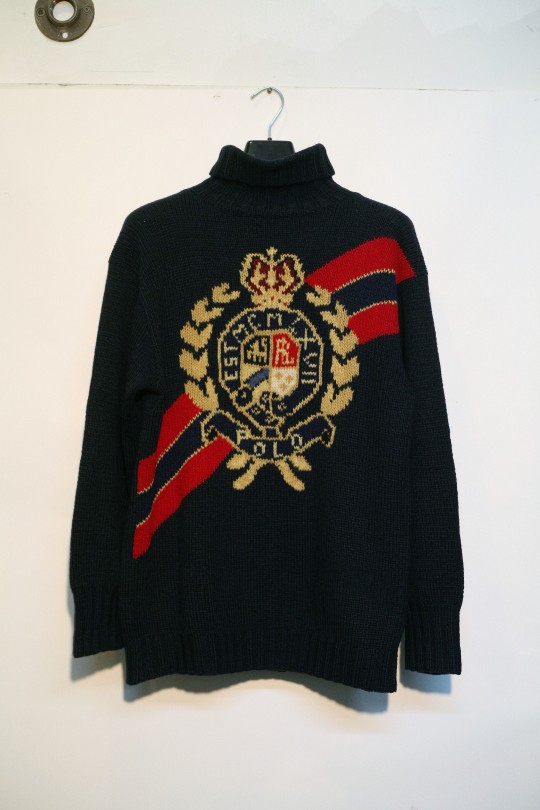
The Crest stands for Royalty and Loyalty. Reminiscent of a British Coat of Arms, this turtleneck was originally released as a Women’s piece in 1992, making this size Large the biggest fit available. The wool hand knit fabric feels luxurious, the crown resembles a majestic style and the 2 diagonal red stripes add flash to this classic look. The Greek lettering celebrates the creation of Ralph Lauren with EST MCMLXVII (1967), the POLO lettering is a tradition of an insignia of this style. This design was the start of what would later become the Polo Crest Fragrance and accessories. The details within this icon add to the graphic and have earned it the title of the POLO Crest.

The Red Line sweater is part of the P-Wing series, released in 1992 as part of the Stadium collection. The size Medium boat neck cotton sweater features a felt varsity style P-Wing patch on the chest. The piece earned its nickname referring to the red stripes on both arms. Considered among collectors to be rarest piece within the entire P-Wing series, this sweater is more rare and more coveted than even the cream P-Wing rings knit. The powerful icon and the stripes on the arms have earned this piece the title of The Red Line.
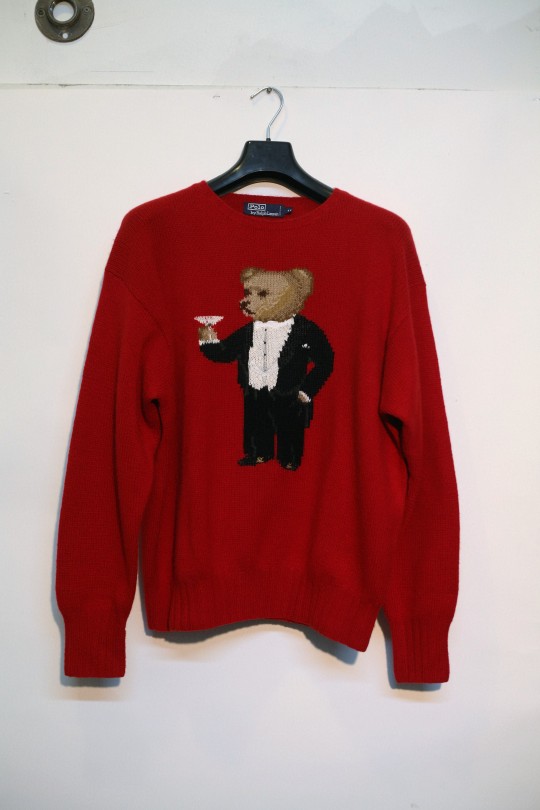
The Red Cashmere Martini Bear sweater was released in 1992 and was the first bear sweater to use cashmere materials. Previously Bear sweaters were only wool or cotton. This sweater was so rare, that among collectors in the late 90’s there was discussion if the sweater even existed as no one wore it or had pictures of it. Despite the urban legend, this sweater was actually featured on the back cover of the Polo Holiday 1992 catalog with a $1495 retail price. The sweater was named for the Bear who holds a Martini glass, while wearing a tuxedo, and tuxedo slippers featuring the RL insignia. There are two versions of this sweater, the turtleneck from the catalog, and the crew neck seen here. This sweater was produced with suit sizing, the inside size label is a 44, equivalent to an XL. Often compared to the Grey Cashmere Bear sweater from 1994, this version is more luxurious, rare and high end. This is the original Red Cashmere Martini Bear.
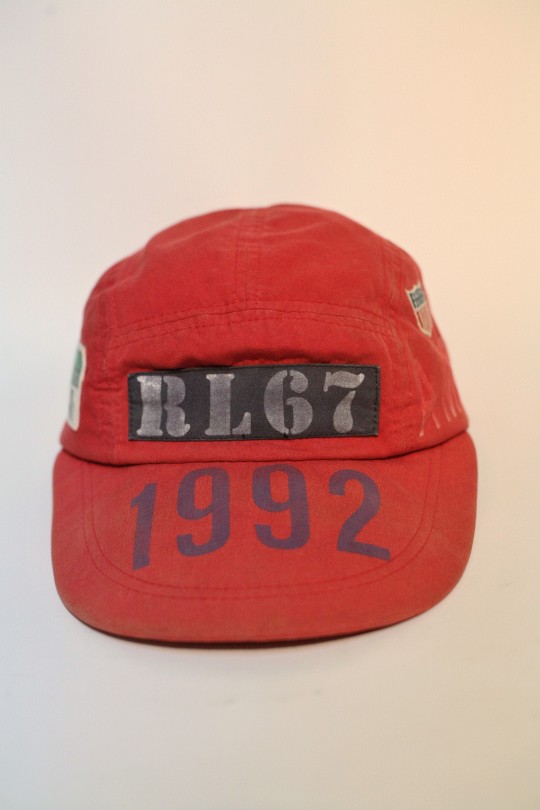
The Red Stadium Hat was released in 1992 as part of the Stadium series. Considered to be one of the rarest hats and the best of the three Stadium hats, because it’s the only one with printed lettering on the bill. This Made in USA, one size fits all elastic back long bill hat is a true classic among the collection. Featuring the 1992 printed on the bill, the RL67 printed patch sewn on the front crown, “AMERICA” printed on the right panel, with an embroidered American flag (referred to by collectors as the K-Swiss icon, named for its similarity to the K-Swiss logo), the “POLO printed on the back panels, and the printed Stadium patch sewn to the left panel. All of these details have earned this piece the distinct title of The Red Stadium Hat.

The Snow Beach Vest is part of the Snow Beach series released in 1994. This size Medium vest features Polartec fleece lining and zipper pockets. The vest is more rare than the Snow Beach “Raekwon” jacket. Among collectors in the 90’s the Beach vest was one of the first pieces to have a higher price tag compared to other pieces from the era. The dark navy blue silk screen printed SNOW on the front and BEACH on the back match the fleece lining and create the exclamation point of the Snow Beach series. The embroidered HI Tech patch on the chest aligns this vest with other Polo pieces from the Polo Hi Tech series, but it is the American Flag Snow Beach patch that give this piece the name the Snow Beach vest.

The Rasta Tank was released as part of the 1992 Stadium series. It is rumored that Jamaican Polo collectors in the early 90’s gave this piece it’s nickname based on the colors resembling the Jamaican flag and bright colored tank tops worn by Rastafarians during the ‘92 era. Pieces like these gave birth to the vibrant colors seen years later by brands like Cross Colors. The heavy knit colorful cotton, and multi-color embroidered POLO stitching make this piece stand out from the rest of the Stadium series, but it is the 1992 printed plates patch that has made this a collectors item. There is a similar design with white rings around the arm bands of this Made in USA size XL tank top; that design is rumored to be the Japanese version of the piece. Often reminiscent to the funky colorful clothing from the film “Cool Runnings” from the same ‘92 season, this has and will always be the Rasta Tank.

The Downtown Grey Cashmere Bear sweater is one of the most coveted pieces in this collection. Released in 1994, nicknamed the Downtown Bear because of the Bear’s dress code resembling the cool downtown New York art gallery look. Also nicknamed the G bear referring to the $1000+ retail price, and the $1000+ resale value. The size Large turtleneck sweater features soft cashmere material and the Bear wears a sleek black suit and loafers. This piece saw a rebirth in 2003 when rapper Fabolous wore the sweater in the music video for his song Baby. The sweater worn in the video was a rental from this collection. This is the actual sweater Fabolous wore in the video. If the Red Cashmere is an Ace, this version is a King. Not to be in the same category as the sit down bears, ski bears, or the executive bears, this is the Downtown Grey Cashmere Bear.
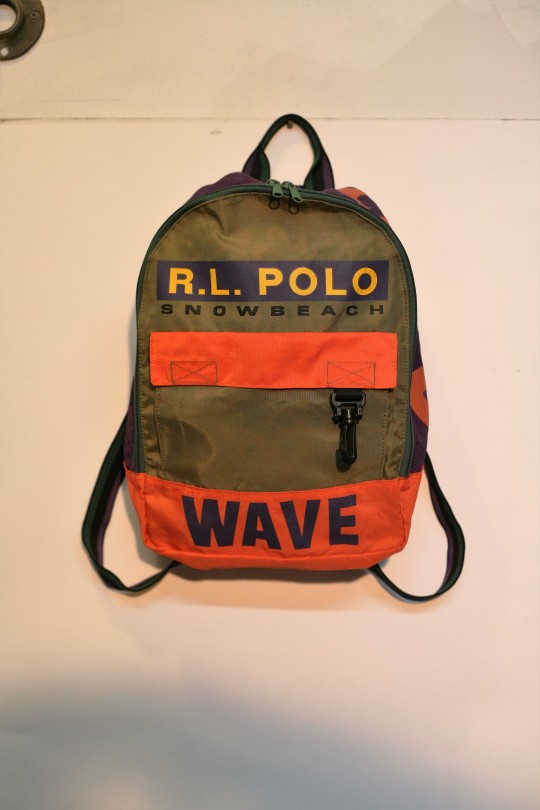
The Snow Beach backpack is part of the Snow Beach/Cold Wave series and is probably the most rare and sought after accessory of the entire vintage Polo collection. The size of the bag is small compared to other items in the Snow Beach series. It is rumored that the one size fits all bag might have been for the boys section, to go with the boys Snow Beach “Raekwon” Pullover, that only had enough space to print the word “SNOW.” The colorblocking and the design make this bag one of most rare pieces within the Snow Beach mini-collection, earning this piece the name The Snow Beach Backpack.
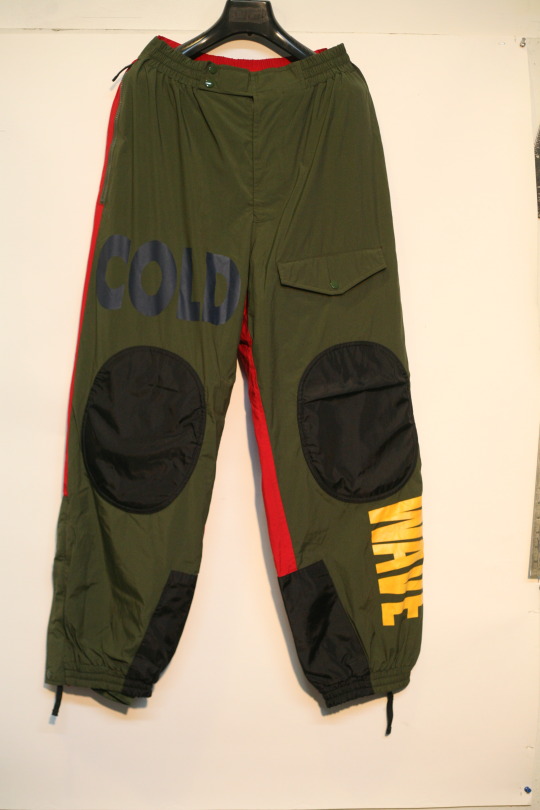
The Cold Wave Pants were released in 1994 as part of the Snow Beach series. While the Snow Beach “Raekwon” jacket is one of the most famous Polo pieces, the Cold Wave pants are much more rare and exclusive. These size Large pants have a loose baggy fit, which was fitting for the era; most of the Snow Beach series was made to be oversized. The series was designed as a SnowBoarding collection, during a time when the new sport was just starting to get some media hype into the mainstream winter sports scene. The nylon tech pants feature padded back and knee panels, zipper pockets, Polo Sport patch on the back pocket, but it is the silk screened letters that give this piece the name The Cold Wave Pants.
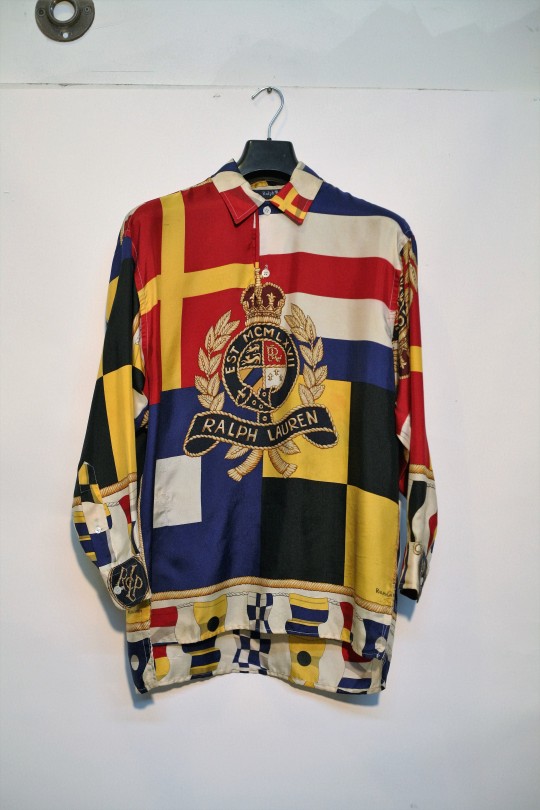
The Silk Crest is a celebration of Royalty meets Wild Style. The design features sailing flags, color blocked panels and the Ralph Lauren crest. Originally released as a women’s piece, this size large is the biggest size available. This piece was one of the first items that the original Lo-Lifes stole, wore and posed with in group photos. The colors are vibrant, the silk is smooth and the Ralph Lauren name in the right corner is reminiscent of silk scarves of the era. Not to be confused with the Barbershop Silk featuring a similar Navy and Red design, this version is also not the short sleeve version that is rumored to have been altered because the long sleeves were not long enough for some buyers. Nicknames include the crown, or crizzy, but to the original Polo collectors this is only referred to as The Silk Crest.
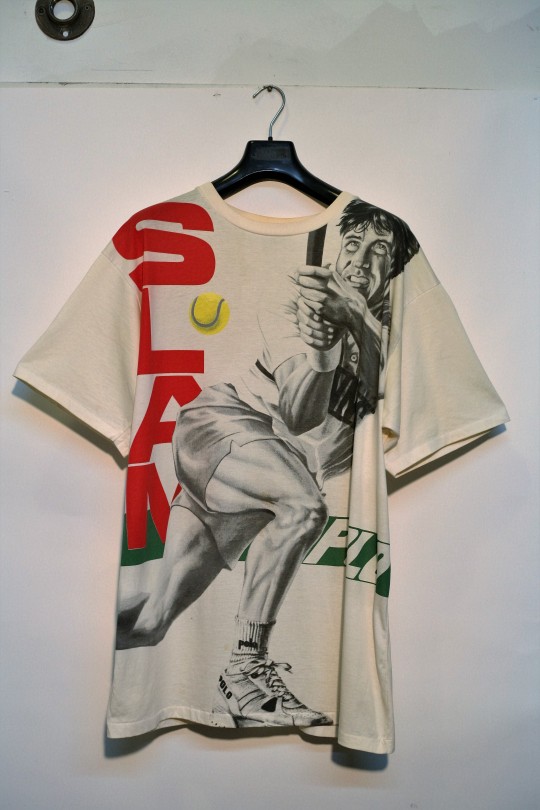
“Slam!” Like the ONYX song from 1993, the graphics in this piece hit you in the face. The tennis player looks similar to Jimmy Connors who still played when this shirt released in the Summer of 1993. The green stripe with the POLO text resembles the top stripe of a tennis net, and the POLO letters on the white sneakers adds a nice feature to this character’s outfit. The cotton is soft, the print has no feel and the fit of this Made in USA XL is oversized. The neon tennis ball provides added color, contrasting against the black and white pencil style drawn athlete, but it’s because of the bold red text that lo heads refer to this garment as “The Slam Tee.”
10 notes
·
View notes
Text
Show Details
Tuesday, September 12 @ 7pm.
Location: Fancy NoLIta Flagship Store
Where Vintage Ralph Lauren meets Hermès bags and Yeezy Sneakers
More info here: http://fancy.to/fancynolita
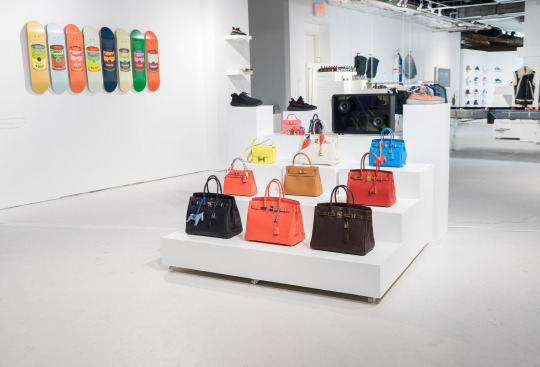
1 note
·
View note
